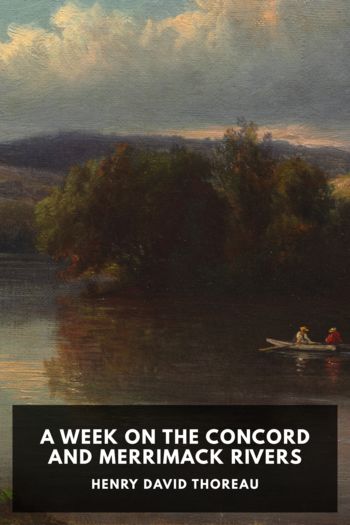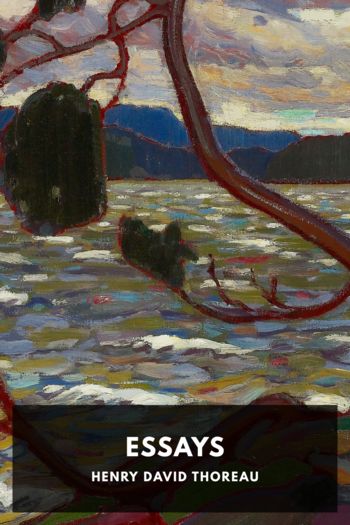Walden by Henry David Thoreau (13 ebook reader txt) 📕

Description
Walden is one of the more famous transcendentalist tracts in modern American literature. First published in 1854, Walden is an account of Thoreau’s famous experiment in solitude: spending over two years alone in a cabin near the wilderness.
Walden is broken into sections that meditate on single themes: economy, reading, sounds, solitude, visitors, and so on. The style is complex, weaving back and forth between simple, home-spun prose and complex allegory, metaphor, and allusion. This makes Walden an interesting read because while it may seem accessible on the surface, it’s a book that requires deep and repeated reading to fully appreciate its many complexities.
Read free book «Walden by Henry David Thoreau (13 ebook reader txt) 📕» - read online or download for free at americanlibrarybooks.com
- Author: Henry David Thoreau
Read book online «Walden by Henry David Thoreau (13 ebook reader txt) 📕». Author - Henry David Thoreau
The whole bank, which is from twenty to forty feet high, is sometimes overlaid with a mass of this kind of foliage, or sandy rupture, for a quarter of a mile on one or both sides, the produce of one spring day. What makes this sand foliage remarkable is its springing into existence thus suddenly. When I see on the one side the inert bank—for the sun acts on one side first—and on the other this luxuriant foliage, the creation of an hour, I am affected as if in a peculiar sense I stood in the laboratory of the Artist who made the world and me—had come to where he was still at work, sporting on this bank, and with excess of energy strewing his fresh designs about. I feel as if I were nearer to the vitals of the globe, for this sandy overflow is something such a foliaceous mass as the vitals of the animal body. You find thus in the very sands an anticipation of the vegetable leaf. No wonder that the earth expresses itself outwardly in leaves, it so labors with the idea inwardly. The atoms have already learned this law, and are pregnant by it. The overhanging leaf sees here its prototype. Internally, whether in the globe or animal body, it is a moist thick lobe, a word especially applicable to the liver and lungs and the leaves of fat (γεἱβω, labor, lapsus, to flow or slip downward, a lapsing; λοβὁς, globus, lobe, globe; also lap, flap, and many other words); externally a dry thin leaf, even as the f and v are a pressed and dried b. The radicals of lobe are lb, the soft mass of the b (single lobed, or B, double lobed), with the liquid l behind it pressing it forward. In globe, glb, the guttural g adds to the meaning the capacity of the throat. The feathers and wings of birds are still drier and thinner leaves. Thus, also, you pass from the lumpish grub in the earth to the airy and fluttering butterfly. The very globe continually transcends and translates itself, and becomes winged in its orbit. Even ice begins with delicate crystal leaves, as if it had flowed into moulds which the fronds of waterplants have impressed on the watery mirror. The whole tree itself is but one leaf, and rivers are still vaster leaves whose pulp is intervening earth, and towns and cities are the ova of insects in their axils.
When the sun withdraws the sand ceases to flow, but in the morning the streams will start once more and branch and branch again into a myriad of others. You here see perchance how blood-vessels are formed. If you look closely you observe that first there pushes forward from the thawing mass a stream of softened sand with a drop-like point, like the ball of the finger, feeling its way slowly and blindly downward, until at last with more heat and moisture, as the sun gets higher, the most fluid portion, in its effort to obey the law to which the most inert also yields, separates from the latter and forms for itself a meandering channel or artery within that, in which is seen a little silvery stream glancing like lightning from one stage of pulpy leaves or branches to another, and ever and anon swallowed up in the sand. It is wonderful how rapidly yet perfectly the sand organizes itself as it flows, using the best material its mass affords to form the sharp edges of its channel. Such are the sources of rivers. In the silicious matter which the water deposits is perhaps the bony system, and in the still finer soil and organic matter the fleshy fibre or cellular tissue. What is man but a mass of thawing clay? The ball of the human finger is but a drop congealed. The fingers and toes flow to their extent from the thawing mass of the body. Who knows what the human body would expand and flow out to under a more genial heaven? Is not the hand a spreading palm leaf with its lobes and veins? The ear may be regarded, fancifully, as a lichen, Umbilicaria, on the side of the head, with its lobe or drop. The lip—labium, from labor (?)—laps or lapses from the sides of the cavernous mouth. The nose is a manifest congealed drop or stalactite. The chin is a still larger drop, the confluent dripping of the face. The cheeks are a slide from the brows into the valley of the face, opposed and diffused by the cheek bones. Each rounded lobe of the vegetable leaf, too, is a thick and now loitering drop, larger or smaller; the lobes are the fingers of the leaf; and as many lobes as it has, in so many directions it tends to flow, and more heat or other genial influences would have caused it to flow yet farther.
Thus it seemed that this one hillside illustrated the principle of all the operations of Nature. The Maker of this earth but patented a leaf. What Champollion will decipher this hieroglyphic for us, that we may turn over a new leaf at last? This phenomenon is more exhilarating to me than the luxuriance and fertility of vineyards. True, it is somewhat excrementitious in its character, and there is no end to the heaps of liver, lights, and bowels, as if the globe were turned wrong side outward; but this suggests at least that Nature has some bowels, and there again is mother of humanity. This is the frost coming out of the ground; this is Spring. It precedes the green and flowery spring,





Comments (0)